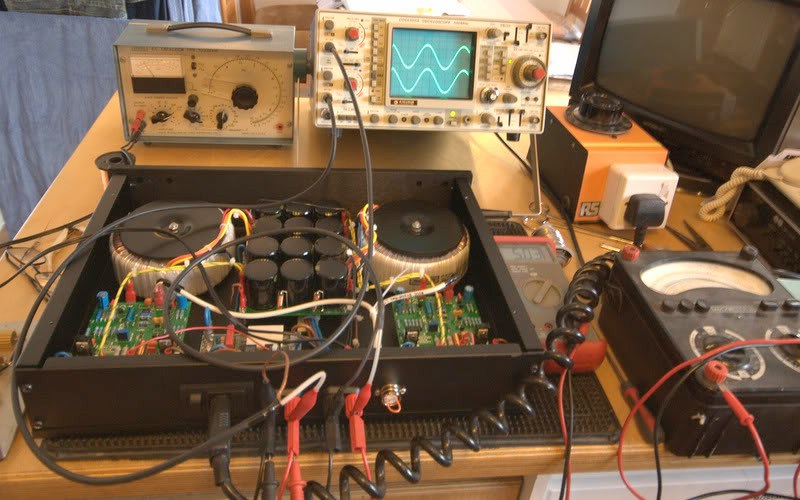Steve Maskery
Established Member
I have a doorbell. On the face of it it is a traditional jingly-jangly spirally-springy doorbell.
Originally it was a simple electrical operation - caller pressed the button, button closed the circuit, motor operated cam, cam waggled bell-spring.
That is fine as long as the bell cabinet is just the other side of the wall to the bell-push. But in my house there is a separation of a couple of metres as well as a couple of walls, and I didn't want to surface-route a bell wire.
So I made it wireless, using a design from Instructables
It's worked fine for years, but the receiver is hungry on batteries, because it is always listening out for a signal.
It recently stopped working again, so I assumed it was the batteries, but after installing a brand new set, it still doesn't work. Nothing. So I've been trying to work out what has gone wrong. This is how it works.
1. Nice brass bell push from Verona makes a contact. √
2. This contact is fed into a plastic wireless bell-push, as if it were the plastic bell-push that had been activated. Plastic bell push lights up and sends a signal.√
3. Wireless receiver receives signal and makes a pin High. Speaker has been removed so that it doesn't play the ghastly midi-tune. √
4. Signal from High pin is connected, via a 1K resistor, to the Base of a transistor. √
5. We'll do step 5 in a mo.
6. When the relay receives a small input voltage, it allows a 9V voltage to flow, which drives the motor which jingle-jangles the bell. √
I think that Step 5 is the problem. The Collector and the Emitter are connected across the input of a solid state relay (Edit - in series with the 3V power supply). When the Base goes High current passes, for as long as the annoying jingle would play if the speaker was attached. At least, that is what is supposed to happen. I know that the relay works, because if I put a voltage across the input manually, I get an output.
So it would seem to me that the transistor has stopped working. Is that likely? Why would a solid-state transistor suddenly stop transisting?
I've ordered some electronic bits and piece to remake the circuit board (I can't find my little stash of components, no doubt they will turn up the day after the new ones arrive). But they will take a while to arrive, so in the meantime I am living in a doorbell-free zone.
I'm just puzzled why something like this would suddenly stop working. Any ideas?
Originally it was a simple electrical operation - caller pressed the button, button closed the circuit, motor operated cam, cam waggled bell-spring.
That is fine as long as the bell cabinet is just the other side of the wall to the bell-push. But in my house there is a separation of a couple of metres as well as a couple of walls, and I didn't want to surface-route a bell wire.
So I made it wireless, using a design from Instructables
It's worked fine for years, but the receiver is hungry on batteries, because it is always listening out for a signal.
It recently stopped working again, so I assumed it was the batteries, but after installing a brand new set, it still doesn't work. Nothing. So I've been trying to work out what has gone wrong. This is how it works.
1. Nice brass bell push from Verona makes a contact. √
2. This contact is fed into a plastic wireless bell-push, as if it were the plastic bell-push that had been activated. Plastic bell push lights up and sends a signal.√
3. Wireless receiver receives signal and makes a pin High. Speaker has been removed so that it doesn't play the ghastly midi-tune. √
4. Signal from High pin is connected, via a 1K resistor, to the Base of a transistor. √
5. We'll do step 5 in a mo.
6. When the relay receives a small input voltage, it allows a 9V voltage to flow, which drives the motor which jingle-jangles the bell. √
I think that Step 5 is the problem. The Collector and the Emitter are connected across the input of a solid state relay (Edit - in series with the 3V power supply). When the Base goes High current passes, for as long as the annoying jingle would play if the speaker was attached. At least, that is what is supposed to happen. I know that the relay works, because if I put a voltage across the input manually, I get an output.
So it would seem to me that the transistor has stopped working. Is that likely? Why would a solid-state transistor suddenly stop transisting?
I've ordered some electronic bits and piece to remake the circuit board (I can't find my little stash of components, no doubt they will turn up the day after the new ones arrive). But they will take a while to arrive, so in the meantime I am living in a doorbell-free zone.
I'm just puzzled why something like this would suddenly stop working. Any ideas?





